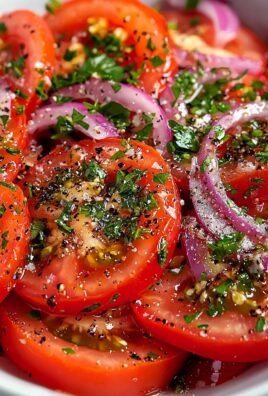Rosemary Sea Salt Bread: Imagine sinking your teeth into a crusty, golden loaf, the aroma of rosemary filling your senses as the delicate flakes of sea salt dance on your tongue. This isn’t just bread; it’s an experience, a simple pleasure elevated to something truly special. I’m thrilled to share my foolproof recipe with you!
Bread, in its many forms, has been a cornerstone of civilizations for millennia. While the exact origins of rosemary in baking are difficult to pinpoint, this fragrant herb has long been associated with remembrance, friendship, and celebration in Mediterranean cultures. Combining it with the simple goodness of bread and the briny pop of sea salt creates a flavor profile that is both comforting and sophisticated.
What makes rosemary sea salt bread so irresistible? It’s the perfect balance of textures – a satisfyingly crisp crust giving way to a soft, airy interior. The rosemary adds an earthy, aromatic note that complements the salty tang, creating a symphony of flavors that will leave you wanting more. Plus, it’s surprisingly easy to make at home! Whether you’re serving it as an appetizer with olive oil, pairing it with a hearty soup, or simply enjoying a slice on its own, this bread is guaranteed to impress. Let’s get baking!
Ingredients:
- For the Dough:
- 4 cups (500g) bread flour, plus more for dusting
- 2 teaspoons (10g) sea salt, plus extra for sprinkling
- 1 teaspoon (3g) instant dry yeast
- 2 tablespoons (30ml) olive oil, plus more for greasing
- 1 3/4 cups (420ml) warm water (105-115°F / 40-46°C)
- 2 tablespoons fresh rosemary, finely chopped
- For the Rosemary Sea Salt Topping:
- 2 tablespoons olive oil
- 1 tablespoon fresh rosemary, finely chopped
- 1-2 teaspoons coarse sea salt flakes (such as Maldon)
Preparing the Dough:
- Combine Dry Ingredients: In a large bowl, whisk together the bread flour, sea salt, and instant dry yeast. Make sure the yeast is evenly distributed throughout the flour. This helps ensure even rising.
- Add Wet Ingredients: Add the olive oil and warm water to the dry ingredients. Use a wooden spoon or your hands to mix until a shaggy dough forms. Don’t worry if it looks a little rough at this stage; we’ll knead it into shape.
- Incorporate the Rosemary: Add the finely chopped fresh rosemary to the dough. Knead it in until it’s evenly distributed. The aroma at this point is just heavenly!
- Knead the Dough: Turn the dough out onto a lightly floured surface. Knead for 8-10 minutes, or until the dough is smooth, elastic, and slightly tacky but not sticky. If the dough is too sticky, add a little more flour, one tablespoon at a time. If it’s too dry, add a teaspoon of water at a time. Proper kneading is crucial for developing the gluten, which gives the bread its structure.
- First Rise (Bulk Fermentation): Lightly grease a large bowl with olive oil. Place the dough in the bowl, turning to coat all sides. Cover the bowl with plastic wrap or a clean kitchen towel. Let the dough rise in a warm place for 1-1.5 hours, or until doubled in size. This first rise is where the magic happens, allowing the yeast to work its wonders and develop the flavor of the bread.
Shaping and Second Rise:
- Punch Down the Dough: Gently punch down the dough to release the air. Turn it out onto a lightly floured surface.
- Shape the Dough: Divide the dough in half. Shape each half into a round or oval loaf, depending on your preference. You can also shape it into a baguette if you prefer a longer, thinner loaf. To shape a round loaf, gently tuck the edges of the dough underneath, creating a smooth, round surface. For an oval loaf, gently stretch the dough into an oval shape and tuck the edges underneath.
- Second Rise (Proofing): Place the shaped loaves on a baking sheet lined with parchment paper. Cover loosely with plastic wrap or a clean kitchen towel. Let the loaves rise for 30-45 minutes, or until they have almost doubled in size. This second rise, called proofing, allows the dough to relax and develop even more flavor.
Preparing the Rosemary Sea Salt Topping:
- Combine Topping Ingredients: In a small bowl, combine the olive oil, finely chopped fresh rosemary, and coarse sea salt flakes. Mix well. This topping adds a burst of flavor and a beautiful texture to the crust.
Baking the Bread:
- Preheat the Oven: Preheat your oven to 425°F (220°C). Place a baking stone or pizza stone in the oven if you have one. This helps create a crispy crust. If you don’t have a baking stone, you can use a regular baking sheet.
- Score the Loaves: Using a sharp knife or lame (a special bread-scoring tool), score the top of each loaf with a few slashes. This allows the bread to expand properly in the oven and prevents it from cracking unevenly. You can make simple straight slashes or get creative with your scoring patterns.
- Brush with Topping: Brush the tops of the loaves generously with the rosemary sea salt topping. Make sure to get the topping into the scores as well.
- Bake the Bread: Carefully transfer the baking sheet with the loaves to the preheated oven. If you’re using a baking stone, slide the parchment paper with the loaves onto the stone.
- Add Steam (Optional but Recommended): For a crispier crust, add steam to the oven during the first 10-15 minutes of baking. You can do this by placing a pan of hot water on the bottom rack of the oven or by spraying the inside of the oven with water a few times during the first few minutes of baking. Be careful when adding water to a hot oven!
- Bake Time: Bake for 25-30 minutes, or until the loaves are golden brown and sound hollow when tapped on the bottom. The internal temperature of the bread should be around 200-210°F (93-99°C).
- Cooling: Remove the loaves from the oven and transfer them to a wire rack to cool completely before slicing and serving. This is important because slicing the bread while it’s still hot can result in a gummy texture.
Tips and Variations:
- Type of Flour: While bread flour is recommended for its higher protein content, which helps develop gluten, you can also use all-purpose flour in a pinch. The bread will be slightly less chewy, but still delicious.
- Rosemary Alternatives: If you’re not a fan of rosemary, you can substitute other herbs like thyme, oregano, or sage.
- Garlic Infusion: For a garlic rosemary bread, add 1-2 cloves of minced garlic to the rosemary sea salt topping.
- Cheese Addition: Add 1/2 cup of grated Parmesan or Asiago cheese to the dough for a cheesy twist.
- Sourdough Version: For a sourdough version, replace the instant dry yeast with 1/2 cup of active sourdough starter and reduce the water by 1/4 cup. The rising times will be longer, so be patient!
- Storage: Store the bread in an airtight container at room temperature for up to 3 days. For longer storage, you can freeze the bread. Wrap it tightly in plastic wrap and then in foil. Thaw completely before serving.
Troubleshooting:
- Dough Not Rising: Make sure your yeast is fresh and that the water is warm enough (105-115°F / 40-46°C). If the water is too hot, it can kill the yeast. Also, make sure the room is warm enough for the dough to rise properly.
- Bread Too Dense: This could be due to not kneading the dough enough or not allowing it to rise long enough. Make sure to knead the dough for at least 8-10 minutes and allow it to double in size during both the first and second rise.
- Crust Too Hard: This could be due to baking the bread at too high of a temperature or for too long. Try reducing the oven temperature by 25°F (15°C) and checking the bread a few minutes earlier. Adding steam to the oven can also help create a softer crust.
- Bread Cracking Unevenly: Make sure to score the loaves properly before baking. This allows the bread to expand evenly in the oven.
Enjoy your homemade Rosemary Sea Salt Bread! I hope you find this recipe easy to follow and that the bread turns out perfectly every time. Happy baking!
Conclusion:
So, there you have it! This Rosemary Sea Salt Bread isn’t just another bread recipe; it’s an experience. The aroma that fills your kitchen as it bakes, the satisfying crunch of the crust giving way to the soft, airy interior, and the burst of flavor from the rosemary and sea salt – it’s truly something special. I genuinely believe this recipe is a must-try for anyone who appreciates the simple pleasures of homemade bread.
Why is it a must-try, you ask? Well, beyond the incredible taste, it’s surprisingly straightforward to make. I’ve broken down each step to ensure even beginner bakers can achieve bakery-worthy results. Plus, the ingredients are simple and readily available. You probably have most of them in your pantry already! But the real magic lies in the combination of fresh rosemary and flaky sea salt. They elevate this bread from ordinary to extraordinary, creating a flavor profile that’s both comforting and sophisticated.
But don’t just take my word for it! I encourage you to get into your kitchen and give this recipe a whirl. I promise you won’t be disappointed. And the best part? There are so many ways to enjoy it!
Serving Suggestions and Variations:
This Rosemary Sea Salt Bread is incredibly versatile. Here are a few of my favorite ways to enjoy it:
- As a side to your favorite soup or stew: The savory flavors of the bread complement hearty soups and stews perfectly.
- Toasted with a drizzle of olive oil and balsamic vinegar: A simple yet elegant appetizer.
- As a base for bruschetta: Top slices with fresh tomatoes, basil, and mozzarella for a delicious and easy snack.
- In sandwiches: The robust flavor of the bread adds a unique twist to your favorite sandwich fillings. Think grilled chicken, roasted vegetables, or even a simple ham and cheese.
- Grilled cheese: Elevate your grilled cheese game by using this bread! The rosemary and sea salt add a gourmet touch.
- Croutons: Cube the bread, toss with olive oil and herbs, and bake until golden brown for homemade croutons that will elevate any salad.
And if you’re feeling adventurous, here are a few variations you can try:
- Add garlic: Incorporate minced garlic into the dough for an extra layer of flavor.
- Use different herbs: Experiment with other herbs like thyme, oregano, or sage.
- Add cheese: Incorporate grated Parmesan or Asiago cheese into the dough for a cheesy twist.
- Make it a focaccia: Press the dough into a baking sheet, dimple the surface with your fingers, and drizzle with olive oil and herbs before baking.
The possibilities are endless! Feel free to get creative and adapt the recipe to your own taste preferences. I’m confident you’ll find a way to make this Rosemary Sea Salt Bread your own signature bake.
I’m so excited for you to try this recipe! Once you do, please come back and share your experience in the comments below. I’d love to hear what you think, what variations you tried, and how you enjoyed it. Did you serve it with a particular dish? Did you add any special ingredients? Your feedback is invaluable and helps other bakers learn and grow. So, go ahead, preheat your oven, and get ready to bake some deliciousness! Happy baking, and I can’t wait to hear all about your Rosemary Sea Salt Bread adventures!
Rosemary Sea Salt Bread: The Ultimate Guide to Baking Delicious Bread
Crusty and fragrant homemade Rosemary Sea Salt Bread. This easy-to-follow recipe yields two delicious loaves perfect for sandwiches, dipping, or enjoying on their own.
Ingredients
- 4 cups (500g) bread flour, plus more for dusting
- 2 teaspoons (10g) sea salt, plus extra for sprinkling
- 1 teaspoon (3g) instant dry yeast
- 2 tablespoons (30ml) olive oil, plus more for greasing
- 1 3/4 cups (420ml) warm water (105-115°F / 40-46°C)
- 2 tablespoons fresh rosemary, finely chopped
- 2 tablespoons olive oil
- 1 tablespoon fresh rosemary, finely chopped
- 1-2 teaspoons coarse sea salt flakes (such as Maldon)
Instructions
- Combine Dry Ingredients: In a large bowl, whisk together the bread flour, sea salt, and instant dry yeast.
- Add Wet Ingredients: Add the olive oil and warm water to the dry ingredients. Mix until a shaggy dough forms.
- Incorporate the Rosemary: Add the finely chopped fresh rosemary to the dough. Knead it in until it’s evenly distributed.
- Knead the Dough: Turn the dough out onto a lightly floured surface. Knead for 8-10 minutes, or until the dough is smooth, elastic, and slightly tacky but not sticky.
- First Rise (Bulk Fermentation): Lightly grease a large bowl with olive oil. Place the dough in the bowl, turning to coat all sides. Cover and let rise in a warm place for 1-1.5 hours, or until doubled in size.
- Punch Down the Dough: Gently punch down the dough to release the air. Turn it out onto a lightly floured surface.
- Shape the Dough: Divide the dough in half. Shape each half into a round or oval loaf.
- Second Rise (Proofing): Place the shaped loaves on a baking sheet lined with parchment paper. Cover loosely and let rise for 30-45 minutes, or until they have almost doubled in size.
- Combine Topping Ingredients: In a small bowl, combine the olive oil, finely chopped fresh rosemary, and coarse sea salt flakes. Mix well.
- Preheat the Oven: Preheat your oven to 425°F (220°C). Place a baking stone or pizza stone in the oven if you have one.
- Score the Loaves: Using a sharp knife or lame, score the top of each loaf with a few slashes.
- Brush with Topping: Brush the tops of the loaves generously with the rosemary sea salt topping.
- Bake the Bread: Carefully transfer the baking sheet with the loaves to the preheated oven.
- Add Steam (Optional): For a crispier crust, add steam to the oven during the first 10-15 minutes of baking.
- Bake Time: Bake for 25-30 minutes, or until the loaves are golden brown and sound hollow when tapped on the bottom.
- Cooling: Remove the loaves from the oven and transfer them to a wire rack to cool completely before slicing and serving.
Notes
- Type of Flour: Bread flour is recommended, but all-purpose flour can be used.
- Rosemary Alternatives: Thyme, oregano, or sage can be substituted for rosemary.
- Garlic Infusion: Add 1-2 cloves of minced garlic to the rosemary sea salt topping.
- Cheese Addition: Add 1/2 cup of grated Parmesan or Asiago cheese to the dough.
- Sourdough Version: Replace the instant dry yeast with 1/2 cup of active sourdough starter and reduce the water by 1/4 cup.
- Storage: Store in an airtight container at room temperature for up to 3 days. Freeze for longer storage.
- Dough Not Rising: Ensure yeast is fresh, water is warm (105-115°F / 40-46°C), and the room is warm enough.
- Bread Too Dense: Knead the dough for at least 8-10 minutes and allow it to double in size during both rises.
- Crust Too Hard: Reduce oven temperature by 25°F (15°C) and check the bread a few minutes earlier. Add steam to the oven.
- Bread Cracking Unevenly: Score the loaves properly before baking.





